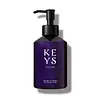What's inside
What's inside
 Key Ingredients
Key Ingredients

 Benefits
Benefits

 Concerns
Concerns

 Ingredients Side-by-side
Ingredients Side-by-side

Water
Skin ConditioningSodium Methyl Cocoyl Taurate
CleansingSodium Cocoyl Alaninate
Cocamidopropyl Betaine
CleansingGlycerin
HumectantButylene Glycol Laurate
EmollientPEG-150 Distearate
EmulsifyingHoney
HumectantChamomilla Recutita Flower Extract
MaskingCurcuma Longa Root Extract
MaskingPEG-150 Stearate
PEG-120 Methyl Glucose Triisostearate
Butylene Glycol
HumectantPEG-4
HumectantPolysorbate 20
EmulsifyingCoceth-7
EmulsifyingPPG-1-PEG-9 Lauryl Glycol Ether
EmulsifyingPEG-40 Hydrogenated Castor Oil
Emulsifying1,2-Hexanediol
Skin ConditioningCaprylhydroxamic Acid
Stearic Acid
CleansingPEG-150
HumectantPropanediol
SolventCaramel
Cosmetic ColorantCitric Acid
BufferingHydroxyacetophenone
AntioxidantPhenoxyethanol
PreservativeEthylhexylglycerin
Skin ConditioningParfum
MaskingChamomilla Recutita Oil
MaskingWater, Sodium Methyl Cocoyl Taurate, Sodium Cocoyl Alaninate, Cocamidopropyl Betaine, Glycerin, Butylene Glycol Laurate, PEG-150 Distearate, Honey, Chamomilla Recutita Flower Extract, Curcuma Longa Root Extract, PEG-150 Stearate, PEG-120 Methyl Glucose Triisostearate, Butylene Glycol, PEG-4, Polysorbate 20, Coceth-7, PPG-1-PEG-9 Lauryl Glycol Ether, PEG-40 Hydrogenated Castor Oil, 1,2-Hexanediol, Caprylhydroxamic Acid, Stearic Acid, PEG-150, Propanediol, Caramel, Citric Acid, Hydroxyacetophenone, Phenoxyethanol, Ethylhexylglycerin, Parfum, Chamomilla Recutita Oil
 Reviews
Reviews

Ingredients Explained
These ingredients are found in both products.
Ingredients higher up in an ingredient list are typically present in a larger amount.
Parfum is a catch-all term for an ingredient or more that is used to give a scent to products.
Also called "fragrance", this ingredient can be a blend of hundreds of chemicals or plant oils. This means every product with "fragrance" or "parfum" in the ingredients list is a different mixture.
For instance, Habanolide is a proprietary trade name for a specific aroma chemical. When used as a fragrance ingredient in cosmetics, most aroma chemicals fall under the broad labeling category of “FRAGRANCE” or “PARFUM” according to EU and US regulations.
The term 'parfum' or 'fragrance' is not regulated in many countries. In many cases, it is up to the brand to define this term.
For instance, many brands choose to label themselves as "fragrance-free" because they are not using synthetic fragrances. However, their products may still contain ingredients such as essential oils that are considered a fragrance by INCI standards.
One example is Calendula flower extract. Calendula is an essential oil that still imparts a scent or 'fragrance'.
Depending on the blend, the ingredients in the mixture can cause allergies and sensitivities on the skin. Some ingredients that are known EU allergens include linalool and citronellol.
Parfum can also be used to mask or cover an unpleasant scent.
The bottom line is: not all fragrances/parfum/ingredients are created equally. If you are worried about fragrances, we recommend taking a closer look at an ingredient. And of course, we always recommend speaking with a professional.
Learn more about Parfum